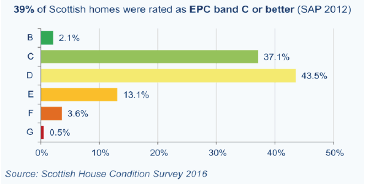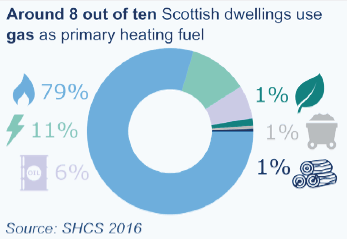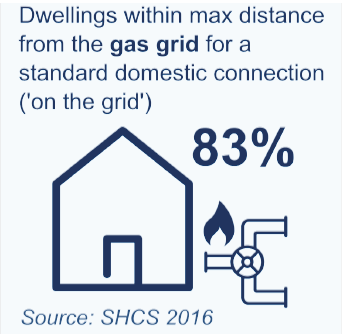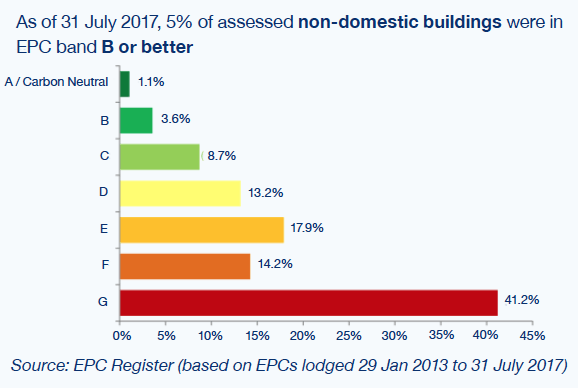Energy Efficient Scotland: route map
This route map for the Energy Efficient Scotland programme sets out the journey our homes, businesses and public buildings will take to become more energy efficient.
Chapter 2: Scotland’s Improving Building Stock
There are around 2.7 million properties in Scotland. They vary widely in terms of building type, use, size, age, construction and energy efficiency, and are situated across all corners of Scotland. Improving the energy efficiency of these buildings to support our work on eradicating fuel poverty and reducing greenhouse gas emissions brings challenges.
Domestic Buildings
In 2016 there were around 2.5 million domestic properties [25] in Scotland and it is likely that over 80% of them will still be in use in 2050. These homes are inter-generational resources and improving these properties today provides better homes for our children and grandchildren. Three quarters of our homes were built before 1982.
A fifth were built before 1919 using traditional methods of construction. The research and development of new approaches for the energy efficiency of these pre 1919 buildings is overseen by Historic Environment Scotland.
Approximately 61% of homes are owner occupied, 15% are privately rented, and 23% are socially rented. [26]
The energy efficiency of Scotland’s homes has been improving in recent years. In 2016, 39% of homes achieved an Energy Performance Certificate ( EPC) rating of C or above. Social housing is generally more energy efficient with 53% rated EPC C or better [27] . This compares to the private sector where 35% achieve a similar rating.
Heating our homes and the water we use accounts for over three-quarters of the energy we use in our homes [28] . The majority of households use mains gas for their heating, with smaller proportions using electricity and oil as their main fuel source. [29]
Infographic:

Infographic Text:
◘ 2.5 million dwellings in Scotland (2016)
Source: National Records of Scotland
Infographic:

Infographic Text:
The Majority of Scottish dwellings are owner occupied (61%)
61% Owner Occupied
15% Private Rented
23% Social Rented
Source: Scottish Government Housing Statistics for Scotland
Infographic:

Infographic Text:
39% of Scottish homes were rated as EPC band C or better ( SAP 2012)
Source: Scottish House Condition Survey 2016
Infographic:

Infographic Text:
Around 8 out of ten Scottish dwellings use gas as a primary heating fuel
Source: SHCS 2016
Infographic:

Infographic Text:
Dwellings within max distance from the gas grid for a standard domestic connection ('on the grid')
Source SHCS 2016
Non-Domestic Buildings
There are approximately 200,000 non-domestic buildings in Scotland, including around 20,000 buildings in public ownership. Our non-domestic buildings are hugely diverse in terms of construction, size and in particular their use, ranging from shops and offices to factories, warehouses and hotels.
We know less about the energy performance of the non-domestic sector compared to the domestic sector. This is largely due to the diverse nature of non-domestic buildings. In addition, far more homes have registered their EPC and we also undertake a large scale annual survey on housing that includes energy efficiency [30] .
As of July 2017, there were around 30,000 non-domestic buildings that have an EPC assessment [31] . Of these 30,000 non-domestic buildings, just five per cent have a rating of EPC B or better; with 22 per cent being rated C or D, and the remaining 73 per cent rated E or worse.
We are currently developing our understanding of the energy efficiency performance of Scotland’s non-domestic building stock, which will be used to inform the development of Energy Efficient Scotland.
EPCs in the non-domestic sector are partly determined by how buildings are used, i.e. type of business, and as a result don’t always directly reflect the actual energy efficiency of buildings. We will be considering this issue as part of our planned work on the Programme.
Infographic:

Infographic Text:
As of 31 July 2017, there were 200,000 non-domestic buildings in Scotland, with 10% of these being public sector buildings
Source preliminary SG analysis
Infographic:

Infographic Text:
As of 31 July 2017, 5% of assessed non-domestic buildings were in EPC band B or better
Source: EPC Register (based on EPCs lodged 29 Jan 2013 to 31 July 2017)
Contact
There is a problem
Thanks for your feedback